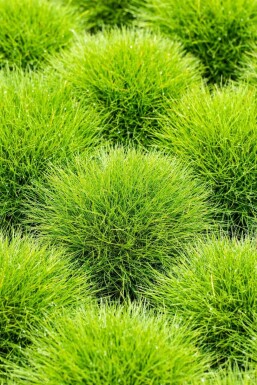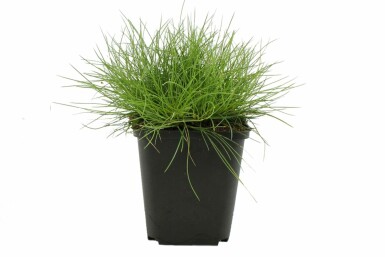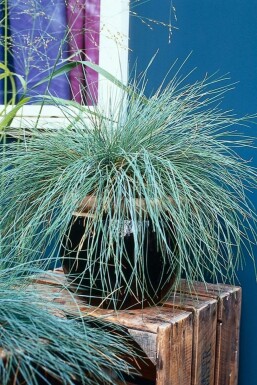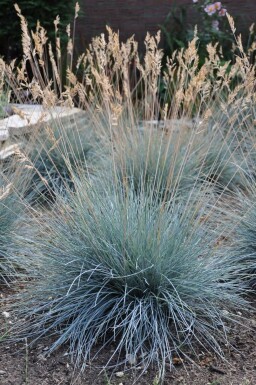

20cm



Discover the elegant charm of Festuca, a genus of perennial evergreen grasses that are essential to crafting a textured and vibrant garden landscape. Renowned for their slender blades which can display a fascinating array of colors from lush green to captivating blue and soft grey, these fescues offer a delightful visual contrast to traditional garden foliage. Native to Southwestern Europe, these hardy plants exhibit a range of subtle flower hues in green, brown, yellow, and white, enhancing their ornamental value. Festuca species provide an effortless grace to any planting design, making them an exquisite choice for gardeners seeking a touch of sophistication without the need for fragrant blooms.


20cm




15cm






40cm











Festuca, commonly referred to as fescue, is a diverse genus of grass with a variety of species that are highly valued for their ornamental qualities and versatility. Originating from Southwestern Europe, the Festuca genus has made its way into gardens worldwide, offering an array of colors and textures for different landscaping needs. These evergreen grasses are particularly noted for their clumping growth habit and the vibrant display of foliage that they present throughout the year.
The Festuca genus boasts several key features that make it a preferred choice for gardeners and landscape designers:
Imbue your garden with the textural finesse of fescues, an ornamental grass celebrated for its hardy nature and striking hues. These clumping beauties offer year-round visual interest with minimal maintenance, elevating the aesthetic of any landscape design. Choose from our selection to add a touch of serene blue or vibrant green to your outdoor tapestry.
We would like to provide some tips on how to plant and care for a Festuca. By following these tips, you can be sure to enjoy your Festuca for a long time.
Festuca species flourish in locations that receive full sun to partial shade, showcasing their vibrant foliage colors which include shades of gold, yellow, blue, grey, and silver throughout the year. These resilient grasses are adaptable to a variety of well-drained soil types, making them versatile for different garden settings. They are particularly suited for border accents, group plantings, or as striking edges in garden designs. Additionally, their compact, clump-forming growth habit ensures they maintain a neat appearance with minimal care, making them an excellent choice for both ground planting and container gardening.
For successful cultivation, Festuca should be planted in well-drained soil, accommodating its versatility across various soil types. This species thrives in both sunny and partially shaded locations. During planting, ensure the clumps are spaced appropriately to allow for their natural spreading. The root ball, nestled in its pot, should be planted level with the soil surface. Initial watering helps establish the plant, but subsequent watering should be moderated, aligning with its average water requirements. Maintaining consistent soil moisture without overwatering is crucial for the development of this evergreen species.
To ensure the vibrant foliage of Festuca remains lush throughout the seasons, a balanced approach to fertilization is recommended. Apply a slow-release, general-purpose fertilizer in early spring to support the growth burst as temperatures rise. This will provide the plant with a steady supply of nutrients during its peak growing season. An additional light feeding can be beneficial in the fall to help maintain its health and color vibrancy as it moves into the colder months. Be cautious not to over-fertilize, as this species is known for its ability to thrive in less fertile conditions, and excessive nutrients can lead to lush but weak growth. Always water the plant after applying fertilizer to help distribute the nutrients into the soil.
Pruning of this species is minimal and primarily for maintenance. In early spring, trim away any dead or damaged foliage to promote fresh growth. This clump-forming grass benefits from an occasional comb-through with gloved hands to remove loose blades and keep the tuft tidy. Cutting back the foliage by approximately one-third every few years can rejuvenate older clumps, encouraging vibrant new growth that showcases the foliage's rich palette of gold, yellow, blue, grey, and silver hues throughout the seasons.
Festuca varieties generally have moderate water needs. It is important to establish a regular watering schedule to ensure the root system develops deeply, which enhances the plant's drought tolerance once established. Over-watering should be avoided, as these grasses prefer well-drained soils and can be more susceptible to root rot in overly moist conditions. During the growing season, if there is insufficient rainfall, provide water to maintain consistent soil moisture. In pots or planters, be mindful to water when the topsoil feels dry to the touch, as containerized plants can dry out faster than those in the ground.
Festuca species boast a clumping growth habit, which can provide a unique texture to garden compositions. Their fine foliage, commonly in shades of blue-green, serves as an excellent contrast against broader-leaved plants, making them a designer's favorite for creating depth and interest in landscape designs. Remarkably, these grasses are also tolerant of a range of soil types, requiring minimal care once established, and they offer a year-round display of color even in cooler climates.
To maintain the robustness of Festuca, division is recommended every few years. This rejuvenates the plant and stimulates new growth. The process involves gently lifting the clump from the soil and teasing apart the sections, ensuring each division has a portion of the root system. It is best to perform this task during the cooler months of spring or autumn to minimize stress on the plants. Once divided, immediately replant the sections into well-drained soil. This practice not only propagates new plants but also helps to keep the original specimens thriving.
Festuca, with its striking blue-green foliage, makes an excellent choice for adding texture and color contrast to your garden. Its clumping habit and drought tolerance ensure low maintenance, while the graceful movement of its blades offers a serene aesthetic. Perfect for rockeries or as a groundcover, Festuca is a garden gem.
